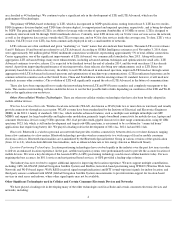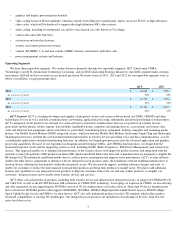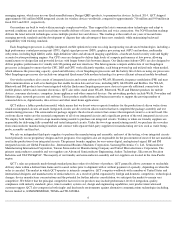Qualcomm 2014 Annual Report Download - page 19
Download and view the complete annual report
Please find page 19 of the 2014 Qualcomm annual report below. You can navigate through the pages in the report by either clicking on the pages listed below, or by using the keyword search tool below to find specific information within the annual report.
industry standards and business models; evolving methods of transmission of voice and data communications; increasing data traffic and
densification of wireless networks; convergence of transmission platforms (including Wi-Fi and small cell infrastructures), which is also
described as the consolidation of access points at the edge of the Internet; networking and connectivity trends (including cloud services);
evolving nature of computing (including demand for always on, always connected capabilities); the speed of technological change (including the
transition to smaller geometry process technologies); value-added features that drive selling prices as well as consumer demand for new 3G,
3G/4G multimode and 4G devices; turnkey, integrated products that incorporate hardware, software, user interface, applications and reference
designs; rapid growth in mobile data consumption; scalability; and the ability of the system technology to meet customers’ immediate and future
network requirements. We anticipate that additional competitors will introduce products as a result of growth opportunities in wireless
communications, the trend toward global expansion by foreign and domestic competitors, technological and public policy changes and relatively
low barriers to entry in certain segments of the industry.
Our future success will depend on, among other factors, our ability to:
Competition in any or all product tiers, customer concentration and/or growth in sales of low-tier products, particularly relative to premium-
tier products, may reduce average selling prices for our chipset products and the products of our customers and licensees. Certain of these
dynamics are particularly pronounced in emerging geographic regions (e.g. China). Reductions in the average selling prices of our chipset
products, without a corresponding increase in volumes, would negatively impact our revenues, and without corresponding decreases in average
unit costs, would negatively impact our margins. In addition,
14
•
develop innovative, differentiated integrated circuit products and technologies across multiple products and features (e.g., modem, radio
frequency front end, central, graphics and/or other processors and connectivity) and with smaller geometry process technologies;
• develop and offer integrated circuit products at competitive cost and price points to effectively cover both emerging and developed
geographic regions and multiple device tiers (e.g., premium- and low-tier smartphones);
• continue to drive the adoption of our integrated circuit products into the most popular device models and across a broad spectrum of
devices, such as smartphones, tablets and other connected devices, and infrastructure products;
• maintain and/or accelerate demand for our integrated circuit products at the premium device tier, while increasing the adoption of our
products in low-
tier devices and in the turnkey product channel, in part by strengthening our integrated circuit product roadmap for, and
developing channel relationships in, emerging geographic regions, such as China and India, and by providing turnkey products, which
incorporate our integrated circuits, for low- and mid-tier smartphones and tablets;
• continue to be a leader in 4G technology evolution, including expansion of our OFDMA-based single mode licensing program, and
continue to innovate and introduce 4G turnkey, integrated products and services that differentiate us from our competition;
• be a leader serving original equipment manufacturers, high level operating systems (HLOS) providers, operators and other industry
participants as competitors, new industry entrants and other factors continue to affect the industry landscape;
• be a preferred partner (and sustain preferred relationships) providing integrated circuit products that support multiple operating system
and infrastructure platforms to industry participants that effectively commercialize new devices using these platforms;
• increase and/or accelerate demand for our wired and wireless connectivity products, including networking products for consumers,
carriers and enterprise equipment and connected devices;
•
become a leading supplier of small cell modems (which enable inexpensive cell sites deployed by users to connect to traditional cellular
networks through wired internet connections) and products that enable Wi-Fi access to support significant network capacity expansion
that will be needed to meet anticipated growth in mobile data traffic;
• identify potential acquisition targets that will grow or sustain our business or address strategic needs, reach agreement on terms
acceptable to us and effectively integrate these new businesses and/or technologies;
• create stand-alone value and/or contribute to the success of our existing businesses through acquisitions and other investments (and/or
by developing customer, licensee and/or vendor relationships) in new industry segments and/or disruptive technologies, products and/or
services (such as the connected home and the Internet of Everything, automotive products, new display technologies, mobile health,
machine learning, including robotics and wireless charging, among others; and/or
• continue to develop brand recognition to effectively compete against better known companies in mobile computing and other consumer
driven segments and to deepen our presence in significant emerging geographic regions.
























